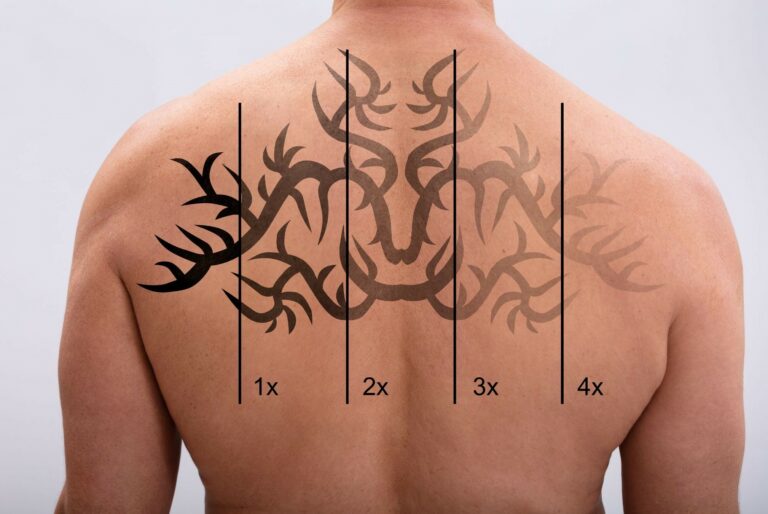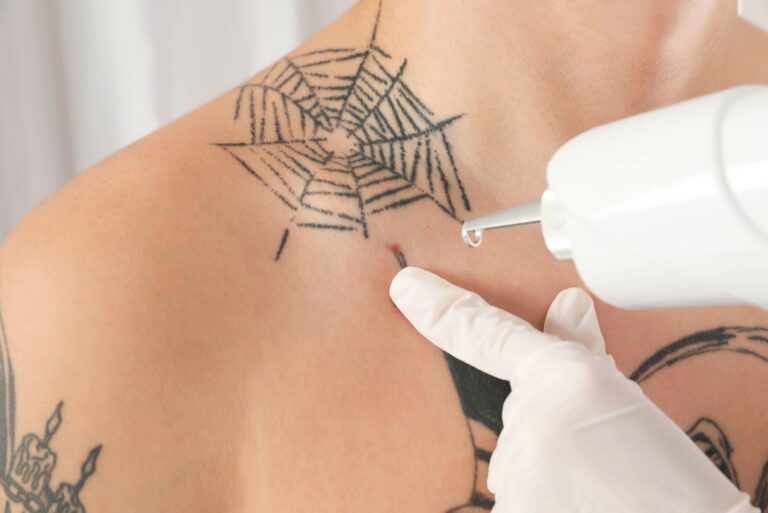Fade Away: A Comprehensive Guide to Understanding Tattoo Removal
The Art and Science of Tattoo Removal
The Popularity of Tattoos
Tattoos have been a popular form of self-expression for centuries. In recent years, they have become even more mainstream, with celebrities and influencers showing off their ink on social media platforms like Instagram.
The reasons behind the popularity of tattoos are varied, but ultimately most people see them as a way to express individuality or commemorate important life events. Tattoos can serve as a permanent reminder of a person’s identity or culture, and can also be used to convey personal beliefs or values.
For some individuals, getting tattooed is a rite of passage, marking the transition into adulthood or an important milestone in life. Additionally, tattoos can be seen as fashionable accessories that enhance one’s aesthetics.
The History of Tattooing
The art of tattooing dates back thousands of years and has been practiced across many cultures around the world. Evidence suggests that ancient Egyptians were among the first to practice tattooing for both cosmetic and religious purposes. Similarly, Polynesians developed intricate tribal tattoo designs that symbolized their social status and personal achievements.
In Western cultures, tattoos were initially associated with sailors and other seafarers who would get inked to commemorate their travels or as a form of identification. Over time, tattoos became more mainstream among counterculture groups such as bikers and punks before eventually gaining wider acceptance in society.
Reasons for Wanting Tattoo Removal
While tattoos are often viewed as permanent symbols representing significant events or beliefs in a person’s life, there may come a time when an individual decides they no longer want their tattoo. This could be due to changes in personal beliefs or tastes over time, regret over past choices made when getting inked, or negative associations stemming from experiences like job loss or discrimination based on appearance. In some cases, tattoos may also be a painful reminder of traumatic events or relationships that an individual would like to forget.
Whatever the reason, tattoo removal has become an increasingly popular option for those who wish to erase their ink and move on from the past. In the following sections, we’ll dive deeper into the science behind tattoo removal, the factors that affect its success, and tips for preparing for the process.
The Science Behind Tattoo Removal
Overview of how tattoos are made in the skin
Tattoos are created by injecting ink into the dermis, the second layer of skin. The needle punctures the skin up to 3,000 times per minute and deposits ink particles into the dermis.
The ink particles are too large for the body’s immune system to remove, so they remain in place indefinitely. This is what makes tattoos a permanent decision.
Explanation of how laser tattoo removal works
Laser tattoo removal uses high-intensity light energy to break down ink particles in the dermis into smaller fragments that can be eliminated by the body’s immune system. Different colors of ink absorb different wavelengths of light, which is why multiple types of lasers may be needed to remove a tattoo with multiple colors.
Types of lasers used for tattoo removal
The three main types of lasers used for tattoo removal are Q-switched Nd: YAG, Alexandrite, and PICO lasers. Q-switched Nd: YAG is most effective on dark-colored inks such as black and blue while Alexandrite works best on green and blue pigments. PICO lasers use ultra-short pulses to shatter ink particles into even smaller fragments than traditional laser treatments.
How the laser breaks down ink particles
The laser energy heats up and shatters the ink particles into tiny fragments that are small enough for white blood cells (macrophages) to engulf and eliminate from your body via the lymphatic system over time.
Importance of multiple sessions
Multiple sessions are required because each session only removes a fraction of the tattoo. The number of sessions needed depends on several factors including size, color(s), location on your body, quality/type/age/pigment depth or concentration/evenly distributed or not/ of the ink, and individual immune system response to treatment.
Other methods of tattoo removal
While laser tattoo removal is the most common method, it is not the only option. Surgical excision involves cutting out the tattoo and stitching the surrounding skin back together.
This method is typically reserved for small tattoos and can leave a scar. Dermabrasion involves physically rubbing the skin to remove layers that contain ink particles.
It can be painful and may also leave scarring. Laser Tattoo Removal is currently the most effective, efficient, and popular means to remove unwanted tattoos permanently with little risk of serious side effects when performed by trained medical professionals using advanced Q-switched Nd:YAG laser machines at a proper dose/application frequency/interval with sufficient cooling techniques & post-treatment care.
Other methods are less desirable due to their risks/limitations/painful nature/costs/time-consuming healing process/scar formation probabilities in many cases, yet they still have applications in some unique situations such as partial removal or cover-up preparation. Understanding how tattoo removal works scientifically will help individuals make informed decisions about which method of tattoo removal is right for them.
Factors That Affect Tattoo Removal Success
Age and location of the tattoo on the body
The age of the tattoo is an important factor in determining how easy it will be to remove. The older a tattoo is, the more likely it is that it will fade with time.
Tattoos on certain parts of the body, such as the hands and feet, are also more difficult to remove due to the thin skin in these areas. Larger tattoos may require more sessions than smaller ones.
Skin type and color
The skin type and color of a person can play a big role in how well their tattoo responds to removal treatments. People with fair skin tend to have better results as compared to those with darker skin tones. This is because darker skin contains more melanin which can absorb some of the laser energy meant for ink particles.
Ink color and quality
Different ink colors have different levels of difficulty when it comes to removing tattoos. Black ink typically responds best to laser treatments as it absorbs all wavelengths of light, while green and blue inks may require additional treatments or specialized lasers due to their chemical makeup. Poor quality ink used by unlicensed artists may also pose challenges during removal due to higher metal content which can lead to scarring.
Preparing for Tattoo Removal
Consultation with a licensed professional
Before starting any tattoo removal treatment, it’s important that you consult a licensed professional who can advise you on your options based on your unique situation. During this consultation session, they’ll examine your tattoos closely, ask about your medical history and outline what kind of results you should expect from each type of treatment.
Understanding potential side effects and risks
Like any medical procedure, there are potential side effects involved with tattoo removal treatments such as blistering, scarring and changes in pigmentation. These side effects can be minimized by following the aftercare instructions provided by your practitioner, but they cannot be entirely avoided.
Aftercare instructions
After each tattoo removal session, it’s important to follow the aftercare instructions provided by your practitioner closely. This may include applying ointment to the treated area, avoiding direct sunlight, and wearing loose clothing to prevent irritation.
The Emotional Impact of Tattoo Removal
Reasons why someone may want to remove a tattoo
There are many reasons why someone may want to remove a tattoo. It could be because of changing tastes or beliefs or simply that the tattoo no longer fits in with their lifestyle or career aspirations. For others, it could be because of trauma associated with a particular period in their life that they no longer want to remember.
Coping with the emotional process
The process of removing a tattoo can be emotionally challenging for many people as it involves letting go of something that was once meaningful or important to them. It’s important to acknowledge these feelings and work through them in order to move forward.
Moving forward after removing a tattoo
While removing a tattoo can be an emotional process, it’s also an opportunity for growth and self-discovery. Many people find that this is an opportunity for them to start fresh and move on from past mistakes and regrets.
Conclusion
Understanding what factors affect the success of tattoo removal treatments is critical before starting any procedure. Always consult with a licensed professional who will guide you on what options are best suited for you based on your situation. Additionally, being aware of potential risks involved with these treatments is crucial while closely following all prescribed aftercare instructions will minimize any risk factors involved during the healing process post-treatment.
references
Laser Tattoo Removal – PubMed (nih.gov)
Medical Disclaimer:
The information provided on this website regarding tattoo removal techniques is for general informational purposes only. It is not intended to be a substitute for professional medical advice, diagnosis, or treatment. Always seek the advice of a qualified healthcare professional regarding any medical condition or concerns, including tattoo removal.
The content presented on this website should not be interpreted as endorsing or promoting any specific tattoo removal technique, product, or service. The effectiveness, safety, and suitability of tattoo removal methods can vary depending on individual circumstances and factors. Therefore, it is crucial to consult with a medical professional or qualified specialist before making any decisions or embarking on any tattoo removal procedure.
The website does not guarantee the accuracy, completeness, or reliability of the information provided. Reliance on any information from this website is solely at your own risk. The website and its owners, authors, and contributors shall not be held liable for any damages or consequences arising from the use of the information provided.
It is important to note that medical practices and standards may change over time, and the information provided on this website may not always reflect the most up-to-date research or guidelines. Therefore, it is recommended to consult with healthcare professionals or reputable sources for the latest information and advice on tattoo removal techniques.
If you experience any adverse reactions, complications, or concerns during or after a tattoo removal procedure, promptly seek medical attention. Only a qualified healthcare professional can assess your specific situation and provide appropriate advice and treatment.
By using this website, you acknowledge and agree to the above disclaimer, and you understand that the website and its owners, authors, and contributors cannot be held responsible for any decisions or actions taken based on the information provided.






